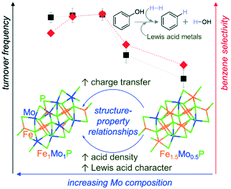Composition-directed FeXMo2−XP bimetallic catalysts for hydrodeoxygenation reactions†
Abstract
The development of task-specific bimetallic phosphide catalysts can be accomplished by exploiting the electronic and bi-functional effects of multiple metal combinations, thus providing materials with tunable catalytic properties. Here, we present the modulation of metal compositions (i.e., Fe and Mo) in the synthesis of FeXMo2−XP (0.88 ≤ X ≤ 1.55), leading to a series of iso-structural, orthorhombic FeXMo2−XP catalysts via reduction at 750 °C. Hydrodeoxygenation of phenol was selected as a probe reaction to showcase the effect of metal composition on the catalytic performance. In particular, catalysts with Fe compositions between 0.99 and 1.14 (i.e., Fe0.99Mo1.01P and Fe1.14Mo0.86P) exhibited high selectivities to C–O bond cleavage of phenol with H2 to form benzene. The catalysts with the highest selectivities to C–O scission also exhibited the highest acidity as determined from NH3 temperature programmed desorption experiments. Density functional theory (DFT) calculations indicate the high Lewis acidity for the ∼1 : 1 Fe : Mo compositions resulted from a greater charge separation between metallic species and P species. These compositions led to greater selectivities to benzene due to desired coordination environment of the phenol on catalytic surface, as evidenced by both DFT calculations and a time on stream study using a benzonitrile poison. Enhanced TOFs were also observed with catalysts exhibiting greater Lewis acid character, which reduce the activation energy required to cleave the C–O bond of phenol, as evidenced by DFT calculations. This structure–property study highlights the effects of metal composition in bimetallic phosphides to enhance the activity and selectivity for C–O bond cleavage reactions.

- This article is part of the themed collection: 2017 Catalysis Science & Technology HOT Articles


 Please wait while we load your content...
Please wait while we load your content...